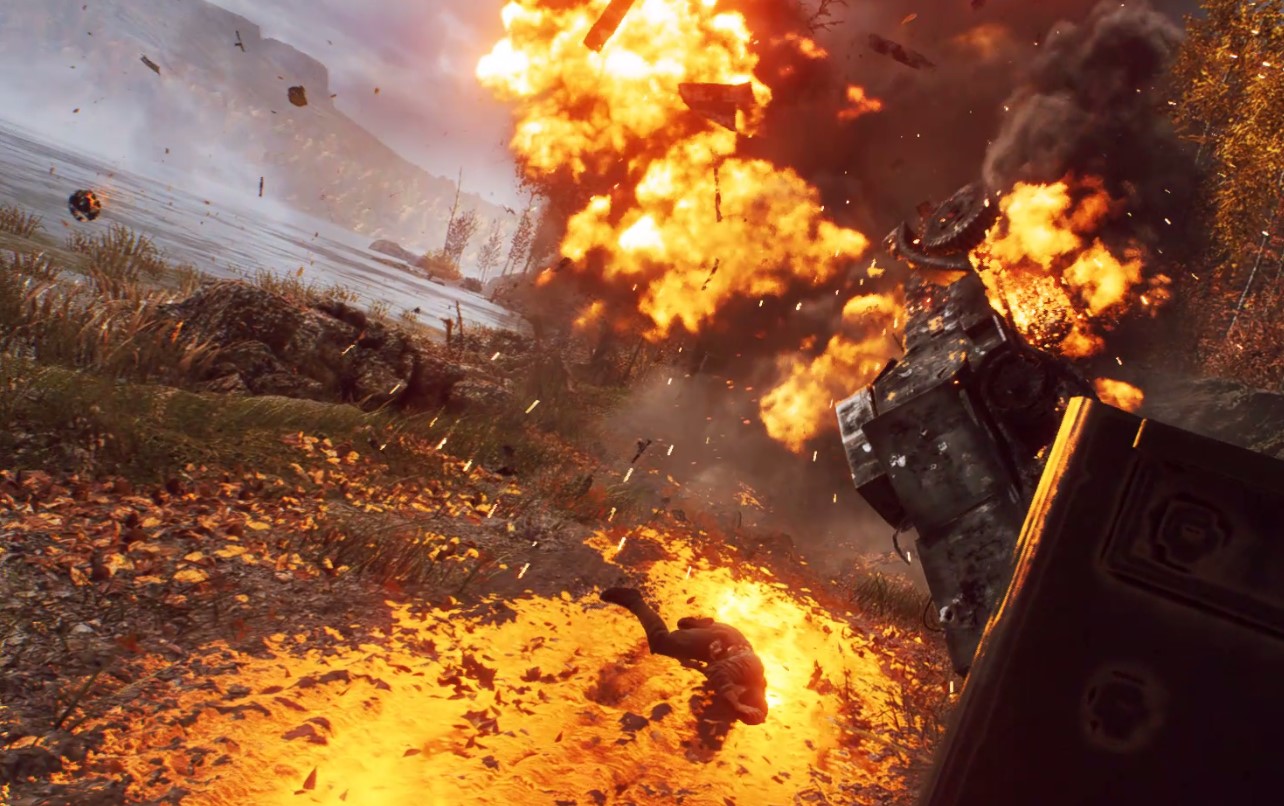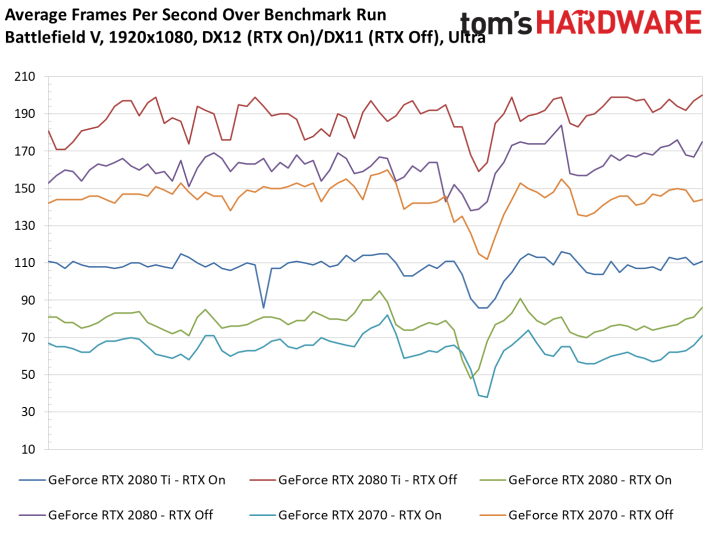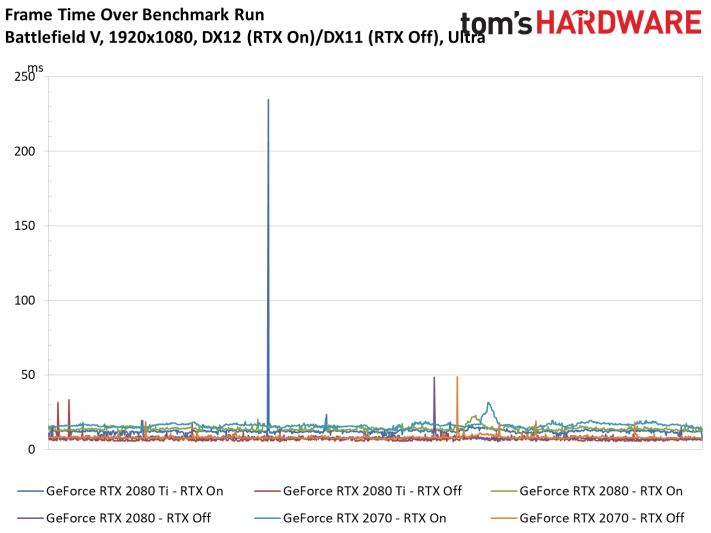Here's How Battlefield V Performs with Ray Tracing
For months after Nvidia’s 20-series GPUs launched with the promise of ray tracing, there was nary a single game that supported the feature. But after an initial delay, Electronic Arts’ Battlefield V now supports the feature, and we’ve finally gotten a real look at what Nvida CEO Jensen Huang called “the Holy Grail of our industry.”
Battlefield V is the first of 11 games announced to support ray tracing. EA and DICE have used it for real-time reflections. We played the game to benchmark performance, but also to see just how impressive this first instance of ray tracing is, and if that visual fidelity is worth the extra load on your system.
Benchmarking Battlefield V
Generating our first set of benchmarks in Battlefield V required an upgrade to our graphics testing platform, which previously hosted a Intel Core i7-7700K. To enable Microsoft’s DirectX Raytracing (DXR) feature, EA recommends an Intel Core i7-8700 or AMD Ryzen 7 2700 CPU. So, we tore apart the old system and rebuilt it with a Gigabyte Z370 Aorus Ultra Gaming motherboard, Intel Core i7-8086K processor and 16GB of G.Skill DDR4-3200 Sniper X memory.
After installing Windows 10 version 1809 (which enables Microsoft's DXR) and updating Battlefield V to the Nov. 14, 2018 Update, we played through to Nordlys: Wolf and Dog. The passage we chose to record lasts 80 seconds. It involves carefully timed and aimed movements that capture reflections off of glass, puddles, and vehicles.
For this initial pass, we wanted one set of presets that’d be comparable across GeForce RTX 2080 Ti, 2080, and 2070 without rendering any of them unplayable. Thus, we tested all three cards at 1920 x 1080 using the Ultra quality preset and the DXR Reflection Quality setting at Medium. Also, Frostbite's engine is known to perform best in DX11 mode, and we experienced some issues while toggling DXR on and off in DX 12, where performance didn't change regardless of settings. To fix that and make sure that DXR was always enabled when we wanted it to be, we decided to do our non-DXR testing under DX11.
A quick look at average frame rate across our benchmark run shows all three DXR-enabled configurations slower than even a GeForce RTX 2070 with DXR turned off.
GeForce RTX 2080 Ti loses 44 percent of its performance under the Medium Reflection Quality setting. The 2080 drops 52 percent. And GeForce RTX 2070 sheds 57 percent. Of course, TU104 contains fewer RT cores than TU102, and TU106 has the fewest RT cores of all. It makes sense, then, that the performance loss attributable to turning DXR on would accelerate down Nvidia’s Turing stack.
Get Tom's Hardware's best news and in-depth reviews, straight to your inbox.
Average frame rate over time illustrates the range of performance each configuration offers through our benchmark sequence. The dip that affects all six runs equally happens when we blow up a cluster of fuel drums right behind a bunch of puddles, creating reflections of the fire on water. Otherwise, even a GeForce RTX 2070 plays fairly smoothly using Medium Reflection Quality.
Aside from a handful of frame time spikes, which look like hitches or brief pauses on-screen, all six runs demonstrate reasonably even frame time delivery.
Frame rates fall off a lot faster at the 99th percentile with DXR off than on. Flipping back to our average frame rates over time chart, we do indeed see a lot more variability in DirectX 11 mode compared to DirectX 12 with DXR enabled.
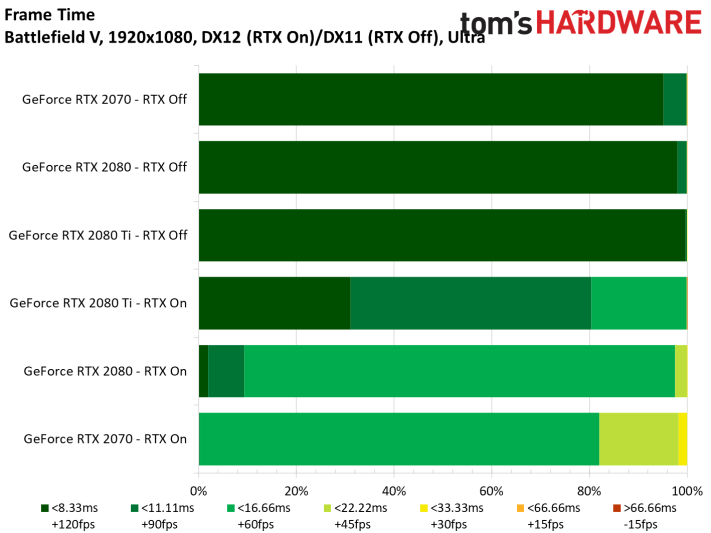

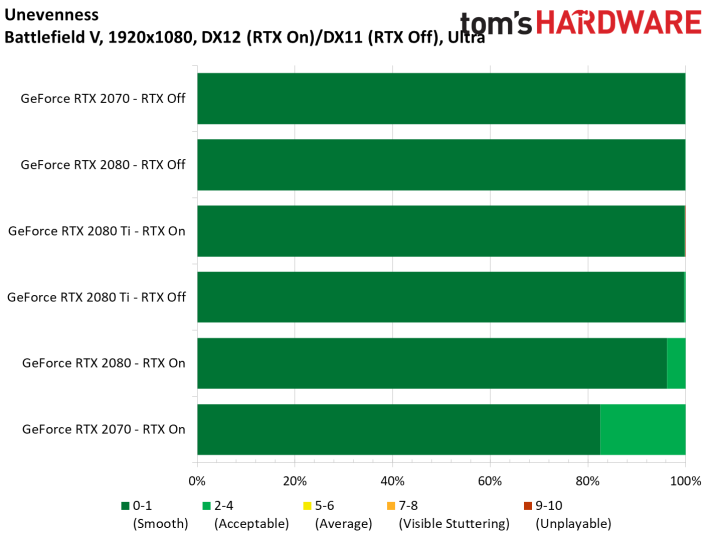
But How Does it Look?
Of course, there’s not just the question of how ray tracing and DXR will make a machine perform. There’s also the question of if the game will look good enough to justify lower frame rates and a more expensive graphics card. Nvidia and EA are still working out ray tracing and have told us that improvements will be made. But the game is available now, and the effects are mixed, at least to our eyes. (For more on the GPU as a whole, see our full review of the Nvidia GeForce RTX 2080 Ti).
While the game was benchmarking on our test bench, we also played through some of the campaign on the Corsair Vengeance 5180 Gaming PC, which boasts an RTX 2080. We ran the game at the same FHD resolution with Ultra presets and medium Reflection Quality.
The first time you see ray tracing and know it, it’s pretty cool. You can see fire explode against the ground in the Tirailleur mission as planes drop bombs on your caravan. In Nordys, you can see the mountains reflected in the far side of a puddle in a pipe you're crawling through. And the reflections shift with your movements. Light shifts on sand as you drive a tank through Libya in My Country Calling. It’s really cool to see what the new tech can do.
But that’s when we were looking for it. That’s not to say we didn’t find it naturally sometimes, but when playing the game’s campaign or multiplayer while trying not to get shot, higher frame rates and resolution offer more benefit to the game than seeing light from an explosion bounce off the side of a tank.
Of course, we do know other games will use ray tracing in other ways. Shadow of the Tomb Raider, for instance, will use it to render more lifelike light and shadows. Developers will have to come up with a good combination of shadows, reflections and other ray-traced effects to make the performance hit worth it.
For competitive play, in Battlefield V right now? Play without ray tracing and get higher frame rates. It’s a better experience.
-
s1mon7 The framerates are really a massive buzzkill considering that we are talking about medium reflection settings, with very few reflections and at 1080P.Reply
The way I see it, it's not even something to consider on set-ups that people actually currently use. It's unrealistic for people to buy a 2080Ti for a 1080P monitor just to run a scarce amount of medium quality RTX reflections at stable 60fps in a few select games (because even the regular 2080 is too weak to accomplish that!)
Since some people are already switching to 4K monitors, it looks like RTX is clearly not going to be playable for them for a very long time. Makes me wonder what's the adoption of the technology going to look like on dev's side, knowing the technology would require significantly more GPU firepower to be actually usable. -
Giroro So what's causing the drop in framerates when ray tracing is enabled, since all that should be doing is turning on extra dedicated hardware.Reply
It seems that the Ray Tracing hardware is still weak and out of balance compared to the powerful GPU, but if ray tracing is the bottleneck, then I wouldn't expect a higher resolution to has as much as a drop because the number of rays calculated should be constant?
I don't know, between the ill performing ray tracing and useless AI hardware... it's almost like the RTX series is chopped-down enterprise GPU that was designed to live inside of a render farm, not a gaming computer. -
hannibal In other site test, those RTX cards really tumbled when there are a lot of surfaces that offer reflections. So average frame rate tell very little. When there is little or almost none reflections, the game is just slow, but playable. When there are a lot of reflections, the game is really bad!Reply
Yep... These cards are not fast enough for ray tracing yet... well the 2080ti is good for 60fps in almost all situation at 1080p, but that is no good for first person shooters...
Ray Tracing is ok for word adventures and turn based strategy games at this moment, but next generation may actually be useful in more wider gaming situations! Also these cards allows programmers to experience with ray tracing, so that it will be better in the next generation! -
stdragon Reply21492171 said:Since some people are already switching to 4K monitors, it looks like RTX is clearly not going to be playable for them for a very long time. Makes me wonder what's the adoption of the technology going to look like on dev's side, knowing the technology would require significantly more GPU firepower to be actually usable.
I prefer gaming at 1K (1080) anyways as I'll prefer a higher FPS (minimum of 60) if that means sacrificing a higher resolution. The good news is, you can switch a 4K monitor to 1080 without any down-scaling effects as the pixel count divides evenly. So, no "fuzzy" interpolation effects will occur. Now whether or not enabling AA will offset the gains of staying at 1K...well...I suppose that's situational to the game you're playing. Meaning, 4K without AA might be preferred. Maybe. -
jpe1701 Even though the performance cost is high, I'm still surprised the 2070 did as well as it did. I was sure it would be a total dud. If they include rt cores on the 2060 that's going to be a joke though looking at these numbers with only medium settings.Reply -
Gillerer Reply21492243 said:... The good news is, you can switch a 4K monitor to 1080 without any down-scaling effects as the pixel count divides evenly. So, no "fuzzy" interpolation effects will occur. Now whether or not enabling AA will offset the gains of staying at 1K...well...I suppose that's situational to the game you're playing. Meaning, 4K without AA might be preferred. Maybe.
That's not how hardware scalers work. Instead of having special cases for doubling pixels, they always apply the same interpolating scaling algorithm. So regardless of whether the scaling factor is an integer, there will always be blurriness. -
bigpinkdragon286 While I'm looking forward to ray tracing in games, this is just one company's attempt at it, and in the end, none of the reflections in the meager video Tom's shared had any real definition or clarity to them, other than the obvious changes in coloration to the reflective surfaces. Care to show off some vehicle mirrors or glass reflections so we can get a better idea of whether this stuff is going to look gimmicky? I already don't like how the ground looks so artificially reflective. It reminds me of when pixel shaders were new, and devs gave everything a plastic sheen to it because they could.Reply -
thealmightyeyeball Just seems a waste to spend that much for something barely usable.Reply
Buy something cheaper like a 1080ti which will give great frame rates sans RT.
It seems nVidia tried to create an awe factor which is impractical. -
NinjaNerd56 I believe I’ll stick with my GTX1060 and regular old 1080P IPS monitor for a while.Reply -
DXRick Huh? Even Oblivion and Fallout 3 can do dynamic reflections on water and specular lighting on other surfaces (like snow). The ability to make a flat surface (like a mirror) do a realistic reflection has long existed too.Reply
What ray tracing can do is make one surface reflect the reflections of other surfaces and have their lighting influenced by the light reflected from other surfaces. Was that shown in the video? The big orange/yellow explosion reflections on water were possible 12 years ago. I would like to know what in that game is only possible with ray tracing?
In other words, if current games were actually written to max out the current abilities of DirectX and the fastest video cards on PCs (instead of being console ports) we would get a lot more than we get now.
